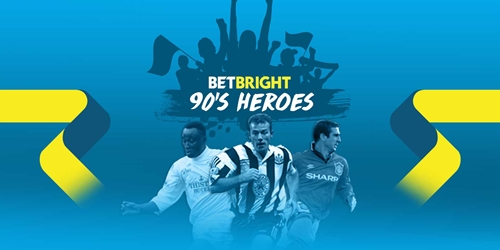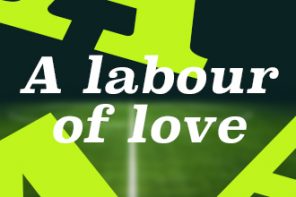’90s Heroes is a series by Adam Hurrey on the Bet Bright football blog which looks back on the legends of the game in what now seems a simpler time for football.
Duncan Ferguson; Jurgen Klinsmann; Faustino Asprilla; Juninho; Tony Yeboah; Georgi Kinkladze; David Ginola; Chris Waddle; Gianfranco Zola; Niall Quinn and Kevin Phillips; Dion Dublin; Robbie Fowler; Stuart Pearce; Mark Hughes; Paul Gascoigne; Matt Le Tissier; Ron Atkinson and Richard Keys; Teddy Sheringham; Dennis Bergkamp; Neil ‘Razor’ Ruddock; Chesterfield FA Cup Heroes; Sky Sports adverts of the 1990s; Kevin Francis; David Platt.
For all the relentless homing in on goal and ritual humiliation of goalkeepers that constitutes 99% of every Romario compilation video on YouTube, there is one image – for which there is little explanation on offer – that demonstrates the lengths some defences had to go to halt him at full steam.
#PSVEindhoven v #AEK Athens (1992/93)#Karayianis #Romario pic.twitter.com/MQhgLY83Pa
— OldFootballPictures (@OldFootball11) May 5, 2016
There’s probably a mundane and disappointingly accidental reason why AEK Athens defender Vaios Karagiannis is scything our hero in two at the neck (an altitude of less than five feet, after all) but, until someone provides it, we can only surmise that Romario’s hat-trick that night had something to do with it.
Karagiannis was far from alone in running out of conventional anti-Romario measures. Take any handful of his 1,000 career goals (or 929, if you’re brave enough to side with FIFA’s statisticians) and you’ll find at least the same number of defenders questioning their earthly purpose after he’s skipped past them on a direct route to goal.
What also strikes you is how little time he wastes wandering left to right with the ball. For a vertically-challenged player, he embraced verticality a long time before this writer even knew it was a word of any footballing consequence. “I have scored against every team, every country, every defender in the world,” he said in 1994 while at the peak of his powers and, by extension, the peak of his self-awareness.
His career, at least for its first decade, seemed to be destined for a similarly direct path to greatness. Plucked from favela obscurity and his youth team of Olaria (whose name, aptly for their role in bringing the substantially-upholstered Romario to the senior game, means “brick factory”) Romario scored 80 goals in four seasons for Vasco da Gama until a predatory showing for Brazil at the 1988 Olympics persuaded Europe’s most successful halfway house to bring him into the footballing mainstream.
Romario, Seoul 1988. pic.twitter.com/1TxzEijUDB
— MoraPicos (@MoraPicos) October 2, 2014
The six-and-a-half seasons of Romario’s main spell in Europe (he subsequently managed to sign for and then depart under a cloud from Valencia twice in the space of a year, with only a distinctly un-Romario-like dipping volley against Atletico Madrid to show for it) represent his unquestionable peak. The numbers may not have dipped as he entered – and exited – his thirties, but here is not the place to debate the relative strength of the labyrinthine Brazilian league system.
With PSV – enjoying the goal-plated stepping-stone of the Eredivisie which has served so many strikers equally well since – and with Barcelona’s “Dream Team”, Romario served up a pulsating demonstration of his unique style. Let’s break it down to the constituent parts.
Out of the blocks
In 1994, Richard Williams, then of the Independent, profiled Brazil’s main man in the lead-up to the World Cup in the USA. “Romario is quick off the mark. At the age of 28, he is probably at the height of his physical powers. But he is only 5ft 6in tall and solidly built. His 11st frame and low centre of gravity give him a scuttling run that is effective rather than elegant”
It’s true to say that – unlike his successor at PSV and Barcelona, Ronaldo, who managed to marry rather more grace with his power – Romario in full flow was not a work of art, at least if you take the ball out of the aesthetic equation. Small enough to worry about not being allowed on some rides at Alton Towers, sprinting for Romario was close to being a biomechanical inconvenience. The first five yards out of the blocks, though, were his domain.
Heading into the new year of 1994, Romario was already 13 goals deep into his debut La Liga season. Real Madrid had taken the first Clasico spoils of the campaign – the Spanish Super Cup – just a few weeks earlier, and Barcelona’s No.10 had been snuffed out by centre-half Rafael Alkorta. Their first league meeting of the campaign called for something extra – and Romario summoned his cola de vaca.
Pep Guardiola enabled the “cow’s tail” with a simple pass to feet at Romario’s outstretched-armed behest on the edge of the area. Alkorta, already three yards away and without another white shirt for company, was already in serious bother even without the benefit of nostalgic hindsight. Romario takes the ball with his instep and steels himself for contact that doesn’t come.
With Alkorta now destined for a thousand 11-second YouTube clips with his name in the title, the same Romario instep whips the ball in an immaculate J-curve. The sheer speed of it generates enough centrifugal force (seriously, it does, you’re watching it happen two paragraphs up) to pin Adidas Tango to Nike Tiempo whether it likes it or not, before sending it smoothly but decisively skidding into the penalty area.
The tricky work complete, the rest is like watching Ben Johnson streak away from the chasing pack in Seoul, minus the stanozolol. If Puskas’ 1953 dragback made Billy Wright look “like a fire engine rushing to the wrong fire”, Romario’s cola de vaca left Alkorta still looking up the address.
Romario puffs his cheeks with the fast-twitch exertion of it all – defender glancing at goalkeeper as the pointless pursuit is instantly abandoned – and twenty yards becomes ten in five explosive strides. What looks like the sixth is, in fact, a stabbed outside-of-the-right-foot finish that is as devastating as anything possible with the left, and ten times more economical and unreadable.
Argentina international and Madridista Jorge Valdano (later of the excellent Ronaldo description “he’s not a man, he’s a herd”) begrudgingly declared that Romario was “like a player from a cartoon”. A widescreen one, too.
One-on-one
Meandering dribbles clearly weren’t Romario’s jam – too much effort, presumably – but there was always room for at least one flourish on the route from A to B. In September 1993, with Brazil’s progress for the World Cup in the balance after Bolivia had handed them their first ever qualifying defeat, Romario was brought in from the wilderness for the decisive final fixture against Uruguay. With less than 20 minutes to go, a towering back-post header (one of Romario’s lesser-known specialities) settled some nerves, followed soon after by this one-man counter-attack.
It’s not entirely clear what Romario is initially trying to do here, and if that first plan succeeds, but the benefit of the doubt concludes that he sells the goalkeeper a stepover AFTER he’s poked the ball past him. In any case, Robert Siboldi’s last-ditch attempt to punch Romario off his feet to salvage Uruguay’s slender hopes of USA ‘94 is a remarkable piece of goalkeeping desperation.
Romario runs towards the crowd after scoring at old Maracanã (1993) #brazil #psv #fcbarcelona #flamengo #vascodagama pic.twitter.com/6L6hyklpu4
— MotherSoccer (@MotherSoccerNL) February 17, 2016
In 1999, with Romario now back in Brazil to rack up the numbers at home with Flamengo, he produced the long-awaited sequel to 1994’s Cow’s Tail.
In the Alkorta role this time was former gravedigger and future journeyman defender Amaral. A full international for Brazil (for what that was worth in the late 1990s), the Corinthians defender had the misfortune of coming up one-on-one with Romario who, despite having just turned 33 and even more cube-shaped, still had daintiness of foot to match his speed of mind. Once again, the ball was prodded one way and then cushioned the other – momentarily offering Amaral the chance to snatch it, and then taking it away – and the elastico was complete.
That piece of ankle-joint mischief is admirable enough on its own, but Romario always had the end product in mind. In this case, a graceful, effortless toe-poke into the opposite top corner. As if Amaral’s indignity wasn’t enough – he was later nicknamed “Amaral Gump” – Romario topped it up again just last year with a commemorative Facebook post, which makes you wonder what those “On This Day” notifications must be like for someone who scored approximately one thousand professional goals.
“Yo, guys! Today makes 17 years of that goal that you guys don’t forget. Amaral is still looking for the ball today.”
Romario did much of his defender-demolishing work with PSV in the famously accommodating Eredivisie, but he did carry that form into European competition too. In 1989, with PSV chasing a one-goal deficit from the first leg against the finalists from the previous season Steaua Bucharest, they conceded again early on at the Philips Stadion. Two poacher’s efforts from Romario brought the tie level and then eliminated Steaua’s away-goal advantage within four minutes of the second half. In the 86th minute, he thought it best to turn the screw.
… will this be his third? Will this be his third? … It is his third! What a world-class goal. 5-1, Steaua are being humiliated.”
There is so much Romario on show here. As the Guardian’s Rob Smyth puts it, this was “the bit on top of the bit on top of the cherry on the icing on the cake” of a previously precarious-looking European tie against very good opposition. The push-and-run past the first defender – who sticks out a speculative leg as a last, fruitless resort – the pause on the ball to allow the scrambling full-back to charge straight past him, the emphatic dummy that sends the same full-back plus the goalkeeper into simultaneous oblivion, and then the finish from a narrow angle. Humiliation done.
Finishing moves
Romario the sprinter, Romario the piss-taker, but that still leaves Romario the finisher. His weapon of choice most of the time was the toe-poke, a method not usually met with universal acclaim, but devastating in the right hands (or, rather, feet.)
The pure economy of the toe-punt allowed Romario to put together hat-tricks in seemingly no time at all. Another continental victim of PSV-era Romario were AEK Athens – neck-high Vaios Karagiannis and all – whose first-leg lead was also rendered meaningless back on Dutch soil. Two prods of a Romario toe set PSV on the way in 1992, which once again allowed him the opportunity for a late flourish.
Just as against Steaua, there were defenders and goalkeeper left on the turf, and the ball nestling in the back of the net, with Romario scampering off to have his hair ruffled by grateful teammates.
Once his next-level move to Barcelona had been agreed, Romario quickly set about introducing his new club to his methods. A 1993 pre-season friendly against Ajax, as if they needed any Romario refresher course, was the perfect taster.
First, Romario moved through the gears to dink the ball over Edwin van der Sar, who could only sit and roll his eyes in response…
…before that trademark Right Foot Where Surely The Left Would Work finish beat van der Sar again, and the reaction was much the same as before.
Exasperated goalkeepers were something of a trend for Romario in the early-to-mid 1990s. Perhaps his most famous toe-poke came at the Pontiac Silverdome during USA ‘94, an equaliser against Sweden that perfectly captured his sense of timing.
It’s not a remarkable goal on its own – especially by Romario’s standards – but it comes with some serious window-dressing. There’s a 17-year-old Ronaldo, hoping to come on as a sub, but content for now to look like a star-struck child on the touchline. There’s also Thomas Ravelli, whose “what can I do?” gesture says pretty much everything. The Independent described it as “the haunted look of someone being given the bad news by Liv Ulmann in a particularly gloomy Bergman movie”, while Ravelli himself had a more straightforward account:
“I thought he was going to shoot earlier, but he didn’t, and he kept coming towards me, so I started to come out. But then he shot suddenly, only with the end of his toe, very fast, and there was nothing I could do.”
Similarly helpless for a few penalty-area moments were the Milan trio of Paolo Maldini, Franco Baresi and Alessandro Costacurta, who could only stand and watch in 1992 as Romario played heads-and-volleys against himself – toe, chest, knee, bang:
For every practical stab of the ball beyond an onrushing goalkeeper like a Gerd Muller tribute act – O Bombardeiro, if you will – Romario still produced something special too. His competitive Barcelona debut, at home to Real Sociedad, was marked with a ridiculous hat-trick: his first an emphatic solo run and finish, his second a mid-air dink with his trusty right extremity after a rapid one-two, and the third taken on his chest and lifted over the keeper on the volley. If you ever wondered what “aplomb” means, his third strike was the very definition.
All the moments detailed above are what earned some extra patience from pretty much every manager Romario worked under/tolerated. As with every other famous troublemaker, the quotes and anecdotes are legion. Romario’s put-downs didn’t always hit the mark – calling Pelé “mentally retarded” wasn’t in the same class as “a quiet Pelé is a poet” – while his shameless mid-season trips to Brazil surely undermined the devastating work he was doing at his peak in Europe.
Sent home from the World Youth Championship in 1985 for urinating from a Moscow balcony, Romario also abandoned PSV after a wrist injury in 1990 – taking his 31 goals in 26 games back to Rio for some unrepentant Copacabana kickarounds – while Ajax overhauled the deficit at the top of the league. His response? “Everyone knows PSV aren’t capable of playing without Romario.” At Barcelona, he earned himself a convenient winter break with a sucker punch on Diego Simeone, just minutes after coming off the bench against Sevilla.
Romario’s repertoire of habits – the rough and the smooth – burnt twice as bright for half as long as they should have done in European football, that is without question. His premature return to Rio on a personal quest for a millennium of goals – he is said to have called local Eindhoven reporters, years after leaving, to check his pre-season goal tallies for PSV – certainly doesn’t enhance his legacy much, nor do his twilight-year cameos in Qatar, Miami and Adelaide.
Does he care?
Romario relaxing in Rio…a day after famously left-hooking Diego Simeone in Sevilla. #Legend (Photo: VI-Images) pic.twitter.com/cVDUMvAwRC
— A Football Archive* (@FootballArchive) January 29, 2016
Unlikely.
For the latest instalment of ’90s Heroes check out the Bet Bright football blog this week.







